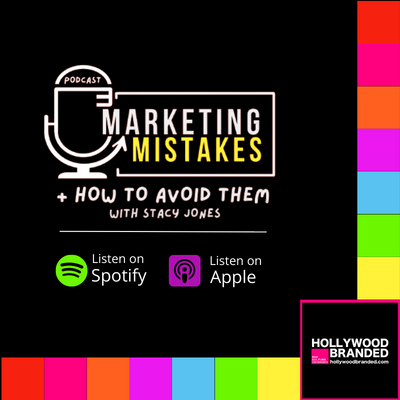Measuring and Valuing Product Placement with Dominic Artzrouni
Table Of Contents
Placing Your Brand For Success
Brands approach company often for looking for ways to increase their brand awareness through product placement. One thing that we discuss in our reporting is how to measure the value of our work - a crucial part of evaluating our own success!
Recently, our CEO Stacy Jones sat down with Dominic Artzrouni and the two discuss their respective experience in product placement and why it is important for brands to be placed in the right context. In this blog, Hollywood Branded learns how to measure the value of product placement from the expertise of Concave Brand Tracking's Dominic Atrzrouni.

A Little More About Dominic
This week, we welcome back a returning guest, Dominic Artzrouni, the founder and director of Concave Brand Tracking, a company that tracks the amount of exposure and impact of a brand from product placement in TV and film content. Dominic founded Concave Brand Tracking back in 2013 by combining his background in business, data analysis and market research with his passion for entertainment. Over the years, he's worked with many major agencies and brands including Dell, Anheuser-Busch and Moët Hennessy. Their list of the most visible product placement brands and movies is one of a kind in this industry.
Interview Transcript Highlights
Question: For those who might not have heard you on our podcast before, can you give everyone just a little bit of a background of who you are and Concave? And what it is that you all do?
Answer: Absolutely. As you said, I've worked in a couple of different fields, which I brought together, data analysis, market research. I've always loved movies and I've always been interested in product placement. I came in with an outsider's point of view with what I'd done in fashion. I said, "Okay. I'm sure this research exists with product placement. What would I expect to see?" One of the biggest things I saw is be able to compare yourself to your competitors and just have this 360-degree view.
For example, what's your ranking compared to all other brands? And when I entered the industry, I realized that it didn't really exist. There were people who measured, who collect the data, but not in a holistic way. Over the years, that's what we've been trying to do at Concave. And the result is, over the last three, four years, this annual report where we've gone through. We started off doing 50 movies a year.
Now we're doing 100 movies a year, which make up about 95% of the box office in the US and about 80% worldwide. So, it's a really good sample. We record every single brand that appears in these movies and a load of data. So, how visible they are, how much screen time, and then also who's using them? This includes what their age is, what their gender is, and what context they're being portrayed in. So it's a hell of a lot of data.
The great thing is, on the one hand for our client, our clients is much more cost effective. And when they come to us, we have years of data. We have all of their competitors, and we can show them that. And I get to have all these great insights that I can share with you today.
Question: So, with this, you're tracking all films. But you also do streaming video on demand and television series also when clients are looking for that, right?
Answer: Yes. So, the TV stuff... so, we do the TV. Unfortunately, we don't yet have a representative sample in the same way we do with movies. Because obviously, there's so many. But actually, something very recent, because some of our clients have been starting to ask that, and we actually took a look to see, "Okay, how many shows would we have to do to get a reasonable representative sample?"
And we found that actually, if you start doing 20, 30, 40 of the highest rated shows in the United States, you start to get about 30, 40... especially this year, unfortunately, with corona, a lot of the show is being slashed because there's going to be a much smaller pool. You can actually get something, a representative. And the reason for that is simply because in terms of viewership, there are hundreds and hundreds of shows that are getting less than a million views.
Whereas, you've got all the primetime shows on the network channels that are getting 10, 15, 20 when you count DVR. And then, you take in the Netflix and the top Amazon shows. And once you get 10, 20 of all of those, you've got a really good sample. So, that's something we're looking at in the future. But at the moment, we do more ad hoc shows like the big story on Stranger Things and most recently, on Space Force.
There's no rules at Netflix. But also, it's the viewership. Because on HBO and Showtime, it's the same thing. But even Billions, which is this amazing show, like the Nielsen ratings are 600,000, 700,000, even with DVR. Obviously, there are a lot of people who are watching it on the HBO streaming. But still, with Space Force they clearly don't think it's done very well because they're not putting out any numbers.
But we've got a model estimate. And we already think over six million people have watched the entire show, which for something that's flopped, is still pretty good.
.png?width=585&name=Screenshot%20(299).png) Image from concavebt.com
Image from concavebt.com
Question: So with the 100 movies that you're doing, the films, how are you choosing? Is that the top 100 box office? Is this based on your clients asking you for specific movies to review? How are you coming up with which movies to review?
Answer: We go on that we use Box Office Mojo as our source. And we look at the top 100 movies at the US box office to make them US-relevant. But then, we're using worldwide figures. So, for example, a movie did well domestically, and same, a 30 million in the US and didn't make any money abroad, it might be less than 100 of the worldwide box office but it's still going to make our sample. Because obviously, all our clients are US-based. So, it's the top 100 brands at the US box office.
Question:And then, where does it go from there? How are you evaluating? How are you determining? Because you have a whole matrix on what something is going to be overall valued with based on the length of time.
Answer: So, the three elements that we look at, as I think I mentioned before, are exposure, demographics and context. Demographics and context, is the qualitative stuff which is more of a cherry on top of the analysis for our clients and stuff. The main crux of what we do and what people are interested in, as you said, is measuring the impact, the exposure. So, we break that down into screen time. So, how long something's on screen?
And that can be cumulative. So, for example, if there's two cars in the background for five seconds, it'll be 10 seconds of total screen time. Then, the discernibility. So, the quality of the exposure. So, the quality of exposure, which has two elements, discernibility, which is where it is. So, is it a close-up? Is it an obvious shot? Is it just subtle? And then, we have discrete. And then, in the background. We think that pretty much covers everything.
And then, whether or not the logo is visible, because that's quite an important metric, which should be logo and a discernibility together, we called the quality of the exposure. And so, we apply that to the screen time. And then, we put that... the way I look at this is we're taking all these different variables, and we're blending them together. So, that's about what you're actually seeing on screen. Then, you've got how many people actually seeing a movie.
And then, you take how much it costs to advertise on US television. So, the cost per million per second. And it's by blending all of this together, we can tell brands that by having 45 seconds with 10 seconds of close-up, 30 seconds in the background with 50/50 logo visibility in a movie, the gross 100 million worldwide, that was worth $300,000 worth of product placement value. So, that's the finished results.
.png?width=586&name=Screenshot%20(300).png) Image from concavebt.com
Image from concavebt.com
Question: And your metrics on how you do and how you come up are very similar with how our agency does as well. So, you have everything covered there. And do you take into account the life of the film after the initial theatrical release when it goes into all those other worlds of on demand and DVD, and airline, and all the different streaming? And then, going into television, going into repeats that are going to be showing up for years and years to come? Or do you just say, "Here's the value from the initial theatrical run"?
Answer: So, you and I actually haven't talked about this before. But this is a brand-new product that we've just been working on, which I was actually planning on talking about. I'm very excited that you brought it up like that. Up until now, the main thing has been, and in every... our analysis will say, "This brand got a million dollars during the..." Well, we just said it because it's a given during a theatrical run.
But recently, we're emphasizing more. Because we've developed a model based on external data. So, actually, this all started with us trying to figure out how many people are watching Netflix movies, which as I've obviously mentioned before, we have found a way to do that. Because Netflix doesn't want to tell us, so we have to do it ourselves. And bringing it down really simply is, obviously, when a movie comes out of the box office and we know how many people see it, there's loads of metrics out on the internet.
There's users who are leaving reviews. There's how much the ratings are. And there's multi... Rotten Tomatoes, Metacritic, IMDb. There's loads of data out there. So, we spent the last year collecting all this data and trying to find what data correlates with the box office. Basically, we've done that and we realized there is a very good correlation with some of these data points. And they allow us to basically apply those to Netflix shows and movies as well to come up with an estimate.
We're not saying it's exact, but it's to give an idea. And so far, we've been proven pretty right with Stranger Things and Extraction. And The Irishman, I think we predicted that it was 28 million people had seen in the first week, and it turned out to be 29. So, we're very happy with that. But when we were doing all this, we realized that, "Wait, all of this data on the internet continues basically forever for all these movies."
So, using that, we are now able to, once a movie is no longer in theater... exactly as you say. Because no one is able to track. Even the most sophisticated data company in the world cannot track, as you said, everything. There's planes, which is the first one. There's pirating, which is a huge... we've actually been contacted by some companies that do track the pirating one. But they keep telling me, "Oh, maybe brands would be interested."
And I tell them, "Trust me, no one is going to want to touch you just as soon as the word, pirated or illegal." But the fact is it is out there, and it is a big... it is a huge thing. And then, Netflix, Amazon, VOD, sometimes we have bought a couple of times for client's data, like actual hard data. Even this hard data, I still got the impression it was a lot of estimates. But how many people are physically renting and VOD purchases, and all that thing in the US?
So, anyway, we're able to put all of that together and come up with these estimates. And so, now, what we're starting to do with our clients is show them... is being able to tell them what people or what value they're getting for the entire lifetime. A perfect example, we did a study earlier this year, was that we took a classic film, Fight Club, which has now been out. It was its 20th anniversary.
Check Out The Podcast!
Dominic has SO MUCH of great information from his experience in product placement, check out the podcast below to learn more about how his company can assess the value of product placement!
Every week we have a marketing professional on our show to share their tips, tricks and lessons learned from their professional experience. Check out some of our other podcast blogs from earlier this year:
Every week we release a new podcast featuring guest's with so much knowledge about marketing, you don't want to miss one! How can you make sure you don't miss an episode? Click below to subscribe!








